By the end of this project you should have completed:
- Game Overview
- Annotated Moodboard
- Annotated Storyboards
- Rules Log
- Game
- Start Screen
- Instructions Screen
- Instructions Screen
- At least 5 customised working levels
- Win Screen
- Lose Screen
- Design Log
- Elements Table
- Full instruction manual (this can be within the game or a separate file)
- Promo Trailer (Checklist)
- Review (Review Checklist)
Make sure you use after school times to complete your game!























